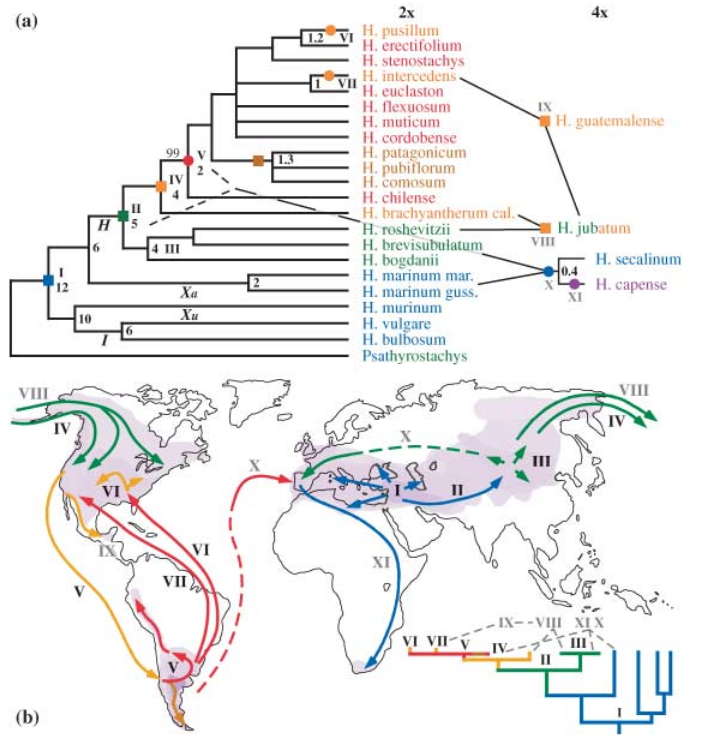Used in:
- Mosiah 5:35 [7:22]
- Mosiah 6:12 [9:9]
- Alma 8:58 [11:7]
- Alma 8:61 [11:14]
What does the Book of Mormon state?
- Barley is not the same as corn
- Mosiah 5:35 [7:22] and 6:12 [9:9] describes barley and corn separately
- Barley is not wheat
At face value - Did barley exist in the New World?
Statement
- Barley (Genus Hordeum)
- Hordeum guatemalense Von Bothmer el at. was recently described as a new species (Von Bothmer et al., 1985). It occurs in a restricted mountain area, the Cuchumatanes, in northern Guatemala near the border to Mexico, where it grows in alpine meadows, above 3000 m.
- Multiple intercontinental dispersals shaped the distribution area of Hordeum (Poaceae)
- New Phytologist, Volume 169 Page 603 - February 2006 doi:10.1111/j.1469-8137.2005.01610.x, Volume 169 Issue 3
- The grass genus Hordeum (Poaceae, Triticeae), comprising 31 species distributed in temperate and dry regions of the world, was analysed [DNA] to determine the relative contributions of vicariance and long-distance dispersal to the extant distribution pattern of the genus.
- The colonization of the New World and South Africa involved at least six intercontinental exchanges during the last 4 million years (twice Eurasia-North America, North America-South America, twice South America-North America and Europe-South Africa).
- Repeated long-distance dispersal between the northern and southern hemisphere were important colonization mechanisms in Hordeum.
Assessment
- Barley (H. guatemalense) is endemic to Mesoamerica
Additional Material
- Barley in the Southwest
- A 1983 article in Science 83 describes archaeological work at the Hohokam site of La Ciudad, near downtown Phoenix, Arizona (the Hohokam culture flourished in the North American Southwest from about 300 B.C. to A.D. 1450). The writer states, "Perhaps the most startling evidence of Hohokam agricultural sophistication came last year when salvage archeologists found preserved grains of what looks like domesticated barley, the first ever found in the New World."
- http://bmaf.org/node/356
- Shortly thereafter, additional samples turned up at other archaeological sites in Oklahoma and Illinois. Of the discoveries made in Illinois, one recent study states that a "previously unidentified seed type . . . has now been identified as little barley (Hordeum pusillum), and there are strong indications that this grain must be added to the list of starchy-seeded plants that were cultivated in the region 2000 years ago."
- Little barley (Hordeum pusillum)
- Barley used before corn
- By the Late Archaic Period, or 2,500 years ago, people's diets were rich in the starchy seeds of chenopod and maygrass, the oily seeds of sumpweed and sunflower, as well as in domesticated pepo squash. Erect knotweed (Polygonum erectum) was another cultivated starchy seed that rose to dietary importance during the Woodland period in parts of the Midwest. Little barley (Hordeum pusillum), a spring/early summer starchy-seeded weed associated with maygrass, is frequently found in the same deposits. By the Middle Woodland Period, or about 2,000 years ago, Indians from the Upper Midwest down to Tennessee were farmers who grew the starchy seed complex (chenopod, maygrass, little barley, and sometimes erect knotweed), pepo squash, bottle gourd, and the oily seeds of sumpweed and sunflower. With this agricultural system well in place, no change can be discerned when maize (Zea mays) was added by 1,850 years ago (see "You Are What You Eat"). It took hundreds of years for maize to become established as an important item in the diet (see "Uses Change Through Time").
- https://gailewagner.weebly.com/sequence-of-domestication-in-eastern-north-america.html
- Barley Distribution
- The image below is from "Multiple intercontinental dispersals shaped the distribution area of Hordeum (Poaceae)," Frank R. Blattner, New PhytologistVolume 169, Issue 3, Article first published online: 10 JAN 2006
- The migration of barley from California (H. brachyantherum subsp. californicum) to Guatemala (H. guatemalense) is labeled as IX on the map and it occurred less than a million years ago (a relatively recent barley migration compared to the other migrations).


